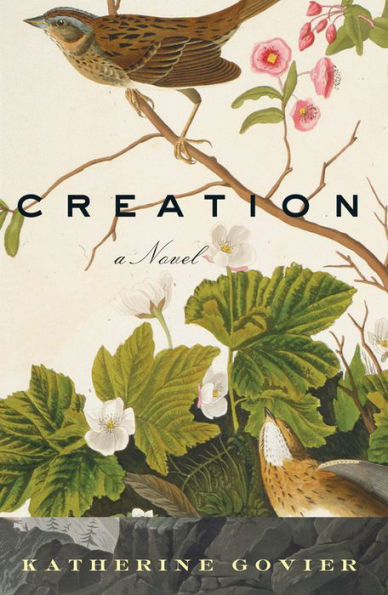Creation: A Novel
A New York Times Notable book about Audubon's voyage to capture Birds of America is a "brilliantly insightful and ravishingly sensuous tale of adventure." (Booklist)
In this atmospheric and enthralling novel, Katherine Govier tells the story of the world's greatest living bird artist as he finally understands the paradox embedded in his art: that the act of creation is also an act of destruction.
Running two steps ahead of the bailiff, alternately praised and reviled, John James Audubon set himself the audacious task of drawing, from nature, every bird in North America. The result was his masterpiece, The Birds of America. In June 1833, partway through his mission, he enlisted his son, Captain Bayfield of the Royal Navy, and a party of young gentlemen to set sail for nesting grounds no ornithologist had ever seen, in the treacherous passage between Newfoundland and Labrador. Creation explores the short, stormy summer throughout which the captain became the artist's foil, measuring stick, and the recipient of his long-held secrets. It is an exploration of that fateful expedition, a probing and imaginative narrative that fills in a gap in the visionary naturalist's well-documented life.
"Carefully crafted and deeply thoughtful." —Kirkus Reviews
1103826120
In this atmospheric and enthralling novel, Katherine Govier tells the story of the world's greatest living bird artist as he finally understands the paradox embedded in his art: that the act of creation is also an act of destruction.
Running two steps ahead of the bailiff, alternately praised and reviled, John James Audubon set himself the audacious task of drawing, from nature, every bird in North America. The result was his masterpiece, The Birds of America. In June 1833, partway through his mission, he enlisted his son, Captain Bayfield of the Royal Navy, and a party of young gentlemen to set sail for nesting grounds no ornithologist had ever seen, in the treacherous passage between Newfoundland and Labrador. Creation explores the short, stormy summer throughout which the captain became the artist's foil, measuring stick, and the recipient of his long-held secrets. It is an exploration of that fateful expedition, a probing and imaginative narrative that fills in a gap in the visionary naturalist's well-documented life.
"Carefully crafted and deeply thoughtful." —Kirkus Reviews
Creation: A Novel
A New York Times Notable book about Audubon's voyage to capture Birds of America is a "brilliantly insightful and ravishingly sensuous tale of adventure." (Booklist)
In this atmospheric and enthralling novel, Katherine Govier tells the story of the world's greatest living bird artist as he finally understands the paradox embedded in his art: that the act of creation is also an act of destruction.
Running two steps ahead of the bailiff, alternately praised and reviled, John James Audubon set himself the audacious task of drawing, from nature, every bird in North America. The result was his masterpiece, The Birds of America. In June 1833, partway through his mission, he enlisted his son, Captain Bayfield of the Royal Navy, and a party of young gentlemen to set sail for nesting grounds no ornithologist had ever seen, in the treacherous passage between Newfoundland and Labrador. Creation explores the short, stormy summer throughout which the captain became the artist's foil, measuring stick, and the recipient of his long-held secrets. It is an exploration of that fateful expedition, a probing and imaginative narrative that fills in a gap in the visionary naturalist's well-documented life.
"Carefully crafted and deeply thoughtful." —Kirkus Reviews
In this atmospheric and enthralling novel, Katherine Govier tells the story of the world's greatest living bird artist as he finally understands the paradox embedded in his art: that the act of creation is also an act of destruction.
Running two steps ahead of the bailiff, alternately praised and reviled, John James Audubon set himself the audacious task of drawing, from nature, every bird in North America. The result was his masterpiece, The Birds of America. In June 1833, partway through his mission, he enlisted his son, Captain Bayfield of the Royal Navy, and a party of young gentlemen to set sail for nesting grounds no ornithologist had ever seen, in the treacherous passage between Newfoundland and Labrador. Creation explores the short, stormy summer throughout which the captain became the artist's foil, measuring stick, and the recipient of his long-held secrets. It is an exploration of that fateful expedition, a probing and imaginative narrative that fills in a gap in the visionary naturalist's well-documented life.
"Carefully crafted and deeply thoughtful." —Kirkus Reviews
2.99
In Stock
5
1

Creation: A Novel
307
Creation: A Novel
307
2.99
In Stock

Product Details
| ISBN-13: | 9781468303933 |
|---|---|
| Publisher: | The Overlook Press |
| Publication date: | 08/16/2022 |
| Sold by: | Barnes & Noble |
| Format: | eBook |
| Pages: | 307 |
| File size: | 3 MB |
| Age Range: | 18 Years |
About the Author
From the B&N Reads Blog
